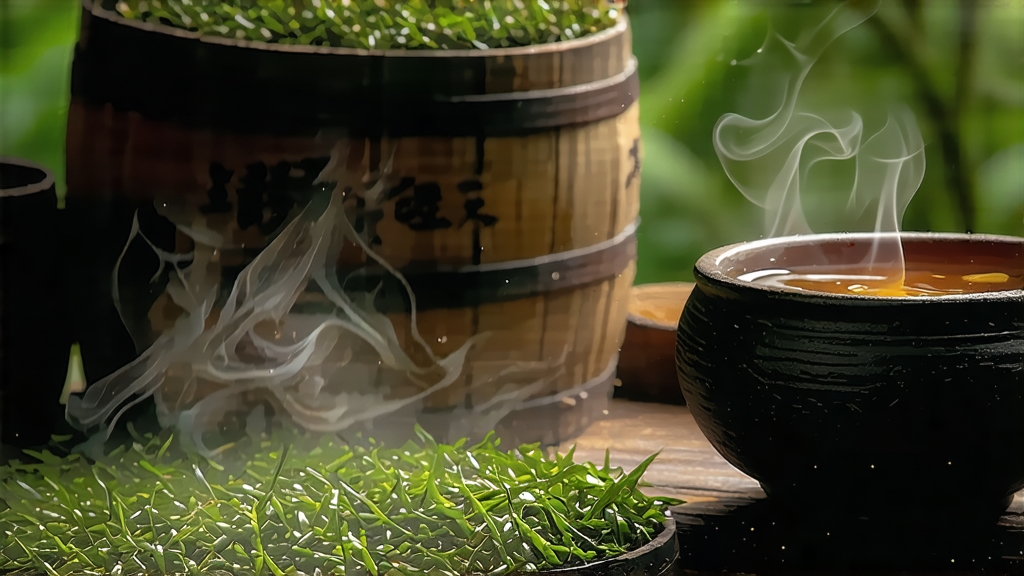
Tucked away in the humid, karst-studded mountains of southern China’s Guangxi Zhuang Autonomous Region, Liu Bao tea has spent four centuries quietly transforming itself from a coolie’s thirst-quencher into one of the most intriguing slow-aged beverages on earth. To most Western drinkers “dark tea” still means ripe Pu-erh, yet Liu Bao is the older, subtler cousin—fermented in bamboo baskets, scented by camphor forests, and prized by Cantonese tea merchants long before the word “pu-erh” ever appeared on a London menu. This article invites you to travel the Liu Bao road: its origin myths, micro-flora, labor-intensive craft, and the almost alchemical changes that occur when time, humidity and human intuition share the same dark leaf.
-
From Border Town to Global Cup: A 400-Year Timeline
Song dynasty records already mention “Yao tea” traded by the mountain-dwelling Yao people for salt and iron, but Liu Bao’s documented history begins in 1585, when the Qing government opened the Wuzhou customs gate on the Xun River. Compressed leaf, steamed and packed into plaited bamboo baskets, was floated downstream to Guangzhou, then transshipped to Hong Kong, Southeast Asia and, via the Straits Settlements, to Calcutta and London. Dockworkers noticed that the deeper the hold, the darker and smoother the tea became—an early lesson in tropical aging. By 1897 Liu Bao accounted for 85 % of Guangxi’s export tax revenue; in 1950s Malaya it was the “miners’ breakfast,” boiled in kettles and sweetened with condensed milk to prevent malaria. Today boutique warehouses in Kuala Lumpur and Taipei guard 30-year vintages that fetch higher prices per gram than first-growth Bordeaux. -
Terroir: Where Camphor Meets River Mist
The Liu Bao micro-region—six villages straddling the confluence of the Liu and Bao rivers—sits at 23 °N, 300–600 m above sea level, inside a belt of evergreen monsoon forest. Day-night temperature swings of 10 °C force the large-leaf Assamica variety to thicken cell walls, storing polyphenols and soluble sugars. More importantly, the air carries spores of Cinnamomum camphora; the same tree whose wood closets protect woollens perfumes the tea with a cooling, mint-like note impossible to replicate elsewhere. Soil is red lateritic clay, acidic (pH 4.8) and laced with iron oxides—minerals that later feed the microbial consortia during fermentation. -
Harvest Calendar: One Leaf, Three Seasons
Only the zhongxiao cultivar—medium-small leaf—survives the humid summers without developing bitter tannins. Spring picking (qingming to guyu) yields floral, apricot-tinged material destined for long aging. Summer tea (lixia to xiaoshu) is fleshier, higher in amino acids, and traditionally used for “quick consumption” Liu Bao pressed into 250 g “tea bricks” for boatmen. Autumn harvest (liqiu to bailu) is the smallest but most prized: cool nights lock in a honeyed fragrance that emerges decades later as “old arbor orchid.” Leaves are plucked with a standard two-leaf-and-a-bud gauge, but the critical difference is the 4-hour “roadside wilt”: baskets are left under banana leaves so ambient yeasts begin weak oxidation before the leaf even reaches the factory. -
Craft: The Eight-Step Bamboo Dance
a. Sha Qing (Kill-Green): 280 °C drum roasters for 3 minutes halt oxidative enzymes yet preserve 15 % residual moisture—higher than green tea, crucial for later microbial bloom.
b. Rou Nian (Rolling): A 45-minute low-pressure roll ruptures 60 % of cell walls without squeezing juice; strips remain intact for airflow.
c. Wei Dui (Wet Piling): Unique to Liu Bao, 80 kg batches are piled 70 cm high, misted to 28 % moisture, covered with wet jute and left for 10–18 days. Internal temperature climbs to 55 °C; thermophilic bacteria (Bacillus subtilis, Aspergillus niger) convert catechins into theabrownins, yielding maroon leaf and